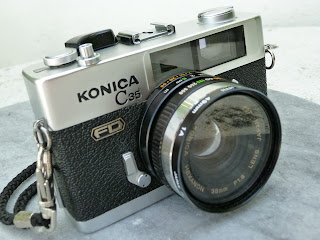My Rolleiflex 2.8C is in perfect working condition except for some slight web-like growth starts to creep in which I noticed and that is worrying me. I have to remove the old leatherette on the top cover before I can unscrew all the screws.There are all together 8 screws appearing on the top cover. Remove all the 6 screws
except those 2 above and below the synchro/flash knob else you have to fix them back later.
Covering my lenses first is a precaution from those sharp objects and screwdrivers! Upon removing the cover, a small B release pin may fall off together with some washers from the 7 screws. Make sure you collect them before proceeding!
Here you can have the chance to tinker with the smallest screw you ever seen on each side of the viewing lens. Removing them and turn anti-clockwise for your cleaning.If you have done this with the cheaper Seagull from China, tinkering with this rather expensive guy here shouldn't be an issue for you!
Another screw here! Try getting ready a magnet as a safety net, just in case! The screw is so small that it won't kill you if you happen to swallow it!!
I have to see how serious is the creepy growth in there before deciding whether the wholes have to be cleaned! Looks like it's just on the first and 2nd level lenses and taking the whole lens out is not necessary at the moment.
Ah,the infected 1st level lens!
See the growth on it? At some point all lenses attracts fungus or creepy growth!
After cleaning with some mildew-fungus preventive solution, the lens looks clean now.
I take the opportunity to take out the taking lens as well. Both are right-threaded and turning anti-clockwise does it. Open up the Bulb aperture and hold it for a while to clean the lens behind the shutter as well! On my way out, I just have to make sure the positions of the shutter knob, synchro/flash knobs etc are in place before covering it.
The next stage is to cut out a new leatherette similar to this old one for my dear 50s' Rolleiflex 2.8C from Germany before my next flirting with it!!
 Never tried any single-lens 6x6 before, I decided to pick up this Perkeo_l just for fun and convenience. As compared to my heavier though much more reliable Rolleiflex TLRs, this camera is so much lighter and can be very convenient to carry around.
Never tried any single-lens 6x6 before, I decided to pick up this Perkeo_l just for fun and convenience. As compared to my heavier though much more reliable Rolleiflex TLRs, this camera is so much lighter and can be very convenient to carry around.
















































